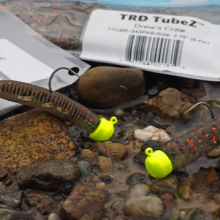This article may contain affiliate links. If you make a purchase after clicking on a link we may earn a small commission at no extra cost to you. As an Amazon Associate, I earn from qualifying purchases.
Ned Rig Setup

The Ned rig is one of only a few finesse style bass fishing techniques. Getting the right Ned rig setup can make all the difference between catching all day and going home skunked.
Most bass fishermen are used to using medium/heavy power casting rods with 20 lb plus braid main line.
Ned rigs are finesse fishing. You will be using 1/16 to 1/4 ounce jig heads and a short soft plastic worm for the majority of your fishing.
- Rod – Spinning rod with a medium/light power rating, less than 7 feet in length and a fast action.
- Reel – Spinning reel in a size 2000 or 3000
- Line – 10 lb braid main line with 6 lb fluorocarbon leader, or 8 lb fluorocarbon main line
Although the above specification for a Ned rig fishing setup are not hard and fast rules the general approach is to use as light as possible a setup as the type of water you are fishing will allow.
Too light and you’ll have a hard time controlling a big bass that has it’s head down in a bed of weed, too heavy and you’ll lack the sensitivity required to get the best out of the jigs.
Ned Rig Setup
These types of presentations require a rod with a light enough power rating to handle casting small jigs and a fast action that gives you a lot of tip sensitivity.
Ask most anglers and you’ll actually get told to go ultralight or medium/light.
Rod
Although a finesse type of rig in the trout fishing world would call for an ultralight rod only when fishing for bass you may need a little more back bone from your Ned rig setup.
In shallow waters that are free from any thick or dense cover an ultralight is actually a good choice.
But;
Once you start fishing near any kind of cover that bass are likely to turn into once hooked the best Ned rig rods to use will have a medium/light power rating.
A bit more backbone is required to steer a bass out from thick weeds. You can still get all the sensitivity you need with a medium/light power rating once the action is fast and the rod is less than 7 feet in length.
The shorter the rod the easier it is to twitch the Ned rig jigs lightly. If you have a long rod then it is very difficult to delicately twitch the jigs.
Reel
Given that you will be using a spinning rod only when using these light jigs a good quality spinning reel is a must.
You need to size the reel appropriately to match your rod and line.
If you choose a reel that is too big then it will throw off the balance point of the rod and make it feel awkward and unbalanced in your hand.
A size 1000 reel if you have one will handle really light lines with ease. You also get less line per turn of the handle so when slowly moving the jig through the water this can be an advantage.
A size 2000 reel is generally best. On a light setup the 2000 is ideal as it will be a few ounces lighter than the larger 3000.
With a size 3000 reel you get a good bit more line capacity.
If you already have a drop shot setup and use a 3000 sized reel then try to get another spool for it and keep that spool purely for Ned rig fishing.
Failing that a size 2000 is the best compromise between either extremes.
Line
Every angler has their favorite line that they swear by. Some are life long monofilament devotee’s regardless of the scenario.
Others will stick with braid for everything.
The correct line choice is the type of line that matches how, what and where you are fishing.
When using a jig you want to have minimal stretch in your main line. The reason for this is that when using a jig you need to add all of the life into the lure by twitching your rod tip.
Too much stretch in your line and you won’t communicate these movements in the correct way.
That is why you should choose either braid or fluorocarbon as your main line.
Both have very little stretch. When using braid you should use a fluorocarbon leader of 4 to 6 feet in length.
Braid is thinner and lighter than fluorocarbon as a main line and it can get you slightly better casts.
The only downside to it is that at very thin diameters it can be prone to wind knotting.
Most Ned rig setups will not use anything heavier than 10 lb braid main line.
